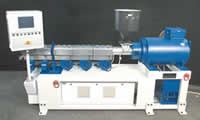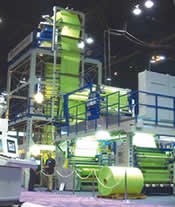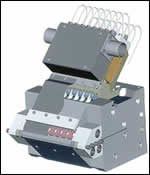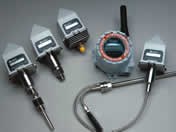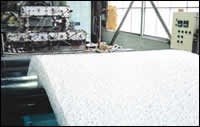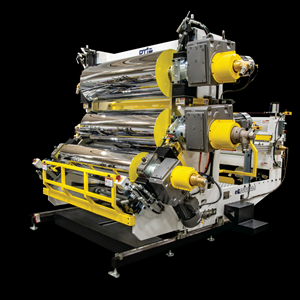NPE News Wrap-Up: Extrusion
Gearless extrusion, cryogenic profile calibration, wireless data communications, and automatic start-up of blown film lines are just a few of the new ways to raise efficiency and output that were highlighted at NPE.
New extrusion technologies at NPE in Chicago in June included a surprising number of world firsts—some specific to one process, but most applicable to any area of extrusion. Some of these “firsts” included commercial gearless electric motors for extruders, computer software that provides automatic start-up of blown film lines, a cryogenic die and calibrator for profiles, and a combination of thermal and mechanical die-lip adjustment for automatic gauge control of film and sheet.
Why go gearless?
Three European motor manufacturers introduced gearless permanent-magnet, synchronous motors at NPE, the first U.S. appearance of this new type of motor at a plastics show. It eliminates maintenance-prone brushes, gears, belts, and encoders. Gearless motors have existed for a decade. The first models were huge—better suited to powering elevators than plastics machinery—and were also low in torque and high in cost.
Bruckner Maschinenbau GmbH in Germany has used the Siemens gearless motor on the downstream stretching components of its oriented film lines, though not on the extruders.
Another source of gearless motors is Baumuller Nurnberger GmbH of Germany, whose Brushless Slotless Disc Motor was first shown to the plastics market at NPE. Sized for plastics machinery, this permanent-magnet synchronous motor has a hollow shaft like the Siemens design. It also boasts high torque of up to 10,000 Nm at low speed. Lengthening the motor by adding a second stator nearly doubles torque at the same diameter, Baumuller says.
ABB also brought to NPE its gearless, permanent-magnet, synchronous motor. It has a solid rather than hollow shaft and is in a traditional cast-iron housing. It goes from 0 to 600 rpm and comes in several sizes. The smallest has 740 Nm torque and weighs 1400 lb. The largest generates power from 17 to 500 Kw and up to 8600 Nm of torque—but weighs three tons. It has been used since last year in European pulp and paper processing, where its enormous size and weight aren’t a problem.
Controls for blown film
Smarter computer software for blown film is allowing less experienced workers to run complex processes. Macro Engineering & Technology has created what it calls the first fully automatic machine start-up software for blown film. Its new FAE (Fully Automated Extrusion) software is designed to speed start-up, especially of coex lines with many layers, which are notoriously operator dependent and may require hours to reach optimal operation. This software will be installed for the first time this month on a three-layer blown film line in Montreal. The second will go on a seven-layer line overseas at the end of September.
With the new program in place, an operator pushes only four buttons: Set-Up Recipe, Start Line, Thread Line, and Shut Off. After pushing Set-Up Recipe, the operator enters film gauge, film width, and resin blend. Then the operator manually threads up the line, and pushes “Start Line.” Everything else happens on its own, Macro says. The computer calculates the complete start-up sequence, including ramping up bubble width and IBC settings. When the processor changes product, the program adjusts automatically to the new set-up, as long as the line remains threaded.
Also shown for the first time at NPE was an automatic start-up module that Hosokawa Alpine American has offered with its Titan controls for about a year. It has eight installations in the field. To initiate the automatic sequence, an operator hits four buttons: Tie On, Pull Up, Through Nips, and On Winders. The software does the rest, automatically ramping up the extruder speeds, blowers, IBC, and new auto-gauging die controls. At the show, Alpine demonstrated 4.5-min automatic start-ups, versus 20 min by hand.
Alpine’s latest Titan controls also include a new troubleshooting module that lets an operator click on a problem, and then it displays the relevant manuals.
Kiefel Inc. showed a new color touchscreen interface for its computer controls. It offers operators a novel troubleshooting feature—a cartoon character named Dr. Wise. Operators tap the Dr. Wise icon on the touchscreen to ask for processing help. They can also program their own solutions into Dr. Wise’s repertoire of advice.
Kiefel also showed a configuration of three ultrasonic sensors on top of the bubble cage that were aligned with three sensors on the bottom. These provide a cascade of bubble diameter information, which results in less variation in layflat width, Kiefel says, especially for films thicker than 6 mils.
Battenfeld Gloucester Engineering Co. says it made a processing discovery during tests in preparation for NPE. Gloucester brought to the show a three-layer, three-extruder blown film line with a 16-in. die, its AutoProfile air ring, and also its relatively new auto die-lip control. The line ran 1.5-mil LLDPE with Kundig thickness sensors. Gloucester found that running both types of gauge controls together shortened start-up time to 15 min vs. 25 min with either gauge-control system alone. “The two controls help each other,” notes process and control systems engineer William Wild.
Several machine makers showed new high-speed winders that are both more compact and able to wind bigger rolls of up to 60-in. diam. For example, Macro’s new 6430 Stackable Turret Winder has a linear lay-on roll instead of a pivoting one, thus requiring less floor space. It can wind up to 60-in. rolls at up to 500 ft/min to keep pace with new high-speed printers.
Addex Inc. claims its new SuperWind high-speed winder is the most compact surface and gap winder yet: It has a 13 x 20 ft footprint and yet can wind up to 58-in. rolls at up to 500 ft/min with up to 80-in. layflat. A cutting knife embedded in the lay-on drum allows reverse winding.
New film haul-offs were also plentiful at the show. Gloucester’s horizontal oscillating haul-off is the first of its own design and construction. Gloucester previously used horizontal oscillating haul-offs from Rheinhold Mas chinen- und Geratebau GmbH in Germany. Its own design has a beefy bearing in the base that is borrowed from Gloucester’s vertical oscillating haul-off and reportedly provides more stability for the nip rolls.
Kiefel also showed a redesigned haul-off. The new Kirion design gives much more rigid support for the collapsing frame and nip rolls.
For cast film and sheet
Barrier cast film and sheet extrusion is getting a lot higher tech. In June, Macro shipped its most complex seven-layer cast film line ever. The line went to China to make meat packaging film. It has nine extruders—seven of 2 to 3.5 in., plus two of 1.75 in. for edge encapsulation. A feedblock and die from Cloeren make a structure of PP-PE-tie-EVA-PVDC-EVA-tie-PE-PE. The structure could be said to have 11 layers, since some of the flow from one tie layer is diverted to encapsulate the PVDC and protect the die from corrosion.
Welex showed off its new double-barrier feedblock technology for making nine-layer film with five extruders. Layers are split in the feedblock to create a structure of surface-tie-barrier-tie-regrind-tie-barrier-tie-surface. By changing the feedblock, the same sheet line can also make a conventional seven-layer barrier sheet of surface-regrind-tie-barrier-tie-regrind-surface.
PTi/Processing Technologies Inc. an nounced a marketing alliance with Bruckner Formtec GmbH in Germany, a subsidiary of Bruckner Maschinenbau. Together, the firms hope to offer a broader line of equipment to a wider range of markets than either can serve alone. PTi is stronger in thick polyolefin films and sheet for automotive markets. Bruckner is stronger in thin PET and PETG sheet for packaging. To begin with, they will jointly market their combined product lines in the hot Asian and Eastern European markets. The second phase, as early as next year, is to develop American versions of Bruckner’s machines for assembly by PTi here, and EU-compliant models of PTi machines for assembly by Bruckner.
NPE saw the arrival of auto-gauging dies whose greater range of adjustability extends automatic gauge control to thicker films. Extrusion Dies Industries (EDI) showed a model of a new die concept for automatic gauge control of thicker sheet and faster gauge adjustment. EDI calls it Autoflex VI L (lever) and is looking for beta sites to test it out. The standard Autoflex die heats a die bolt to deflect the die lip. EDI’s new die magnifies this thermal effect by having the die bolt push against a lever instead that moves the flexible lip twice as far. It’s not for thin films (for which the existing Autoflex VI R die is suitable), but the new die’s longer stroke can control a wider die gap for thicker films like BOPP and sheet for thermoformed packaging up to 0.15 in. It also allows a smaller thermal change to adjust the die twice as fast. EDI believes this is the first combination of thermal and mechanical die-lip adjustment.
Breyer GmbH of Germany also brought a die with more widely tunable lips. The flexible lip on top and adjustable lip on the bottom were previously seen at K2001. Since then, Breyer added a third adjustment possibility to the lower lip. This lip can now be mechanically bent up or down 2 mm with a lever inside the die, which the operator adjusts manually from outside. It can be adjusted on the fly.
Two suppliers in recent months began offering new die and screw coatings for extra wear resistance. Cloeren Inc. showed a die with its new Gemni plating, consisting of nanometer diamond particles in a nickel matrix applied at a thickness of 1 mil.
Meanwhile, Entek Extruders has a proprietary new metallurgy said to give screws extra corrosion resistance. It’s an alloy of powdered stainless steel with molybdenum and vanadium.
Pipe and profile news
A new continuous vacuum-forming technology developed by Cullom Machine Tool & Die didn’t make its promised debut at NPE because Cullom’s assets were acquired in the weeks before the show by Scioto Technologies Inc. of Columbus, Ohio. Scioto is a 14-year-old builder of downstream automation equipment and tooling for corrugated pipe. After acquiring Cullom’s technologies, it changed its name to Modern Machine Corp. Modern is continuing to develop Cullom’s process (PT, May ’03, p. 66) for making a chain of discrete hollow shapes and has two automotive applications in development.
Meanwhile, the general manager and the engineer who developed that process at Cullom were hired by the HPM Div. of Taylor’s Industrial Services LLC, which is now working on a similar process called CVF (continuous vacuum forming). AT NPE, HPM an nounced plans to build a demonstration unit later this year, targeting form-fill-seal containers, which don’t require precise neck threads.
Another novelty—one that did make it to the show—was wireless transmitters that send real-time process data to a remote PLC. Davis-Standard Corp. worked with Adaptive Instruments to develop the system. At the show, Adaptive’s little box-like devices transmitted data from four sensors—melt pressure and temperature, screw speed, and motor load—on a Killion lab extruder to a Davis-Standard EPIC III supervisory control system. Field transceivers with a five-year battery can receive the radio signal up to 3000 ft away. One radio transmitter currently takes data from two sensors but will be able to handle more sensors in the future, Adaptive says.
Material Enhancement International LLC, which had shown a nitrogen profile cooling tank at NPE 2000, launched at this show a high-output combination of a cryogenic die and cryogenic calibrator. The cryo-die injects super-cold nitrogen gas into the profile. More nitrogen is recirculated through the dry calibrator at speeds of 100 mph, creating turbulent cooling. Both are believed to be the first such products sold commercially. The combination can double or triple output of hollow profiles, the company claims. Two commercial applications are using MEI’s cryo-calibrator for profiles, wire, and cable.
Also new for profile extrusion is a highly sensitive laser triangulation technology for measuring the outer dimensions of profiles in-line. Depending on the number of sensors, the system can measure complex curves and indentations in a profile. Bytewise Measurement Systems developed the technology for tire treads and other rubber profiles and began offering it for plastics in the last six months.
Krauss-Maffei of Germany has offered its single-screw extruders in the U.S. since NPE 2000, but only for polyolefin pipe. At NPE 2003, the company extended the single-screw range offered here to include custom profiles of various thermoplastics. It showed a Model KME 45 XS extruder for profiles with 45 mm diam. and 30:1 L/D. It’s also available in 60 mm diam.
Guill Tool & Engineering introduced a mini coex die that measures 2.25 in. diam. x 2.25 in. long, compared with 3 x 4 in. for Guill’s “Micro” die. The new mini die goes on a tiny coextruder for medical tubing of up to 0.25 in. OD. The whole extruder is only 10 in. long and has 0.25 in. diam. and 40:1 L/D.
Uniplast International Inc. (a unit of Greiner in Austria) showed improved profile tooling called E-Tec. This economical tooling consists of three 6-in. calibrator blocks instead of two 9.5-in. blocks. The overall length is the same but the cost is lower and cooling control is reportedly better.
One of the oddest extrusion technologies introduced at NPE comes from EIN Co. Ltd. in Japan. The system extrudes 2000 tiny EVA tubes into a turbulent water bath, where they entangle and stick together before they cool. The mass of tubes is compressed on two sides into a slab that has nearly solid surface layers and a spongy middle. The result is a resilient mattress that’s a lot less expensive than an innerspring mattress and is easy to clean. EIN has one commercial licensee in Japan. The same approach can produce thin slabs of PP/EPDM tubes for automotive seat cushions.
Related Content
Rohm, SABIC Combine on New Film, Sheet Unit
Called Polyvantis, new firm to be a global powerhouse in PC and PMMA extrusion.
Read MoreBanach to Lead Cast Film, Sheet, Coatings at Reifenhäuser
Flat film and sheet veteran has worked for both suppliers and processors.
Read MoreRoll Stand is Compact, Flexible
Streamlined stack is joined by high-speed extruder; service cart for maintaining screws, dies and rolls; and other products.
Read MoreSheet Extrusion, Thermoforming Tips for PLA/aPHA Blends
Biopolymers like PLA and PHA are able to meet sustainability goals while also delivering the performance attributes needed in rigid food packaging. Here’s what testing has shown.
Read MoreRead Next
Lead the Conversation, Change the Conversation
Coverage of single-use plastics can be both misleading and demoralizing. Here are 10 tips for changing the perception of the plastics industry at your company and in your community.
Read MoreFor PLASTICS' CEO Seaholm, NPE to Shine Light on Sustainability Successes
With advocacy, communication and sustainability as three main pillars, Seaholm leads a trade association to NPE that ‘is more active today than we have ever been.’
Read MoreSee Recyclers Close the Loop on Trade Show Production Scrap at NPE2024
A collaboration between show organizer PLASTICS, recycler CPR and size reduction experts WEIMA and Conair recovered and recycled all production scrap at NPE2024.
Read More



